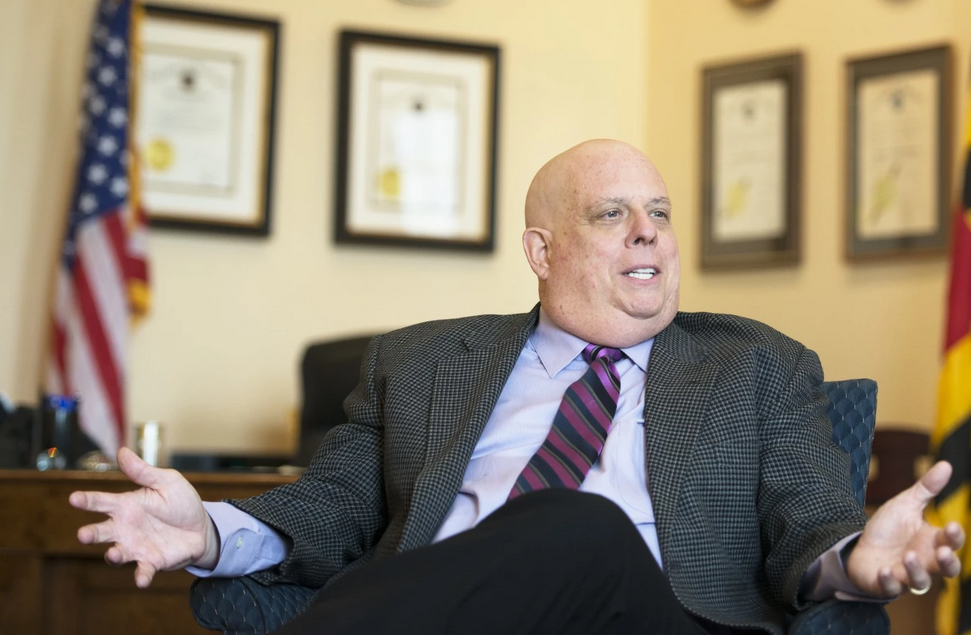
Gov. Larry Hogan’s job approval rating has taken a significant leap in the past seven months.
Eight months into his term, 58 percent of Maryland residents approve of the way Hogan—a Republican in a blue state—is handling his work in Annapolis; 18 percent disapprove; and 23 percent don’t know, according to a new poll from Goucher College.
In Goucher’s February poll, Maryland residents were understandably more hesitant to judge Hogan’s performance—he’d only been in office for a month. At that time, 39 percent indicated they approved of the job he was doing; 17 percent disapproved; and 43 percent did not offer an opinion.
Marylanders are also more optimistic about the direction that the state is heading than they were a year ago. A majority, 56 percent, now believes the state is moving in the right direction, compared to the 38 percent found in Goucher’s September 2014 poll.
It’s interesting to note that while those polled are more optimistic about the state’s future, there wasn’t a great difference between those who said their personal financial situation had improved (29 percent) in the past year and those who said it had worsened (22 percent). Almost exactly half, 49 percent, said their personal economic situation had remained the same. However, when asked to speculate about their personal economic situation a year from now, 47 percent said they expect it to improve; 11 percent expect it to worsen; and 39 percent expect it to stay about the same.
“In the eyes of many Marylanders, Gov. Larry Hogan is off to a good start leading the state,” said Mileah Kromer, director of the Sarah T. Hughes Field Politics Center at Goucher College, in a statement. “What is notable is that his support crosses party lines. Along with his 80 percent approval rating among his fellow Republicans, 54 percent of Democrats approve of the job he’s doing. A tough test of his leadership ability will come this spring, when he has to work with the heavily Democratic legislature to address important statewide issues like education, public transportation, and budgetary policy.”
Regarding the most important issue facing the state, Maryland residents chose education (15 percent); taxes (14 percent); economic growth and development (13 percent); and jobs and unemployment (11 percent).
Support for Hogan does not appear to indicate any sharp right turn, politically, in the state: Marylanders also continue to approve of President Barack Obama’s work in the White House. His job approval rating (53 percent) among Marylanders during his second term in office remains virtually unchanged since last fall. Thirty-eight percent of Marylanders disapprove of Obama’s performance while a whopping 83 percent disapprove of the way Congress is handling its job.
Other numbers from the Goucher Poll:
Marijuana: 52 of Maryland residents support the legalization of marijuana, 42 percent oppose it.
Immigration: 62 percent of Maryland residents believe undocumented immigrants should be allowed to stay in their jobs and eventually apply for U.S. citizenship; 13 percent think undocumented immigrants should be allowed to stay in their jobs as temporary guest workers, but not be allowed to apply for U.S. citizenship; 20 percent believe undocumented immigrants should be required to leave their jobs and leave the United States.
*The Goucher poll notes that although 73 percent of Marylanders believe that the number of undocumented immigrants coming to the U.S. has increased in the past decade, the Pew Research Center, based on Census population estimates, says that the number has remained flat since 2005.
School Start Date: 72 percent support moving the official start date to after Labor Day; 19 percent oppose.
Voting Districts: 21 percent prefer a system where voting district lines are determined by Maryland’s elected officials and 73 percent prefer a system where districts are determined by an independent commission. Currently, voting district lines in Maryland are determined by the state’s elected officials and are readjusted after each U.S. Census.
Conducted from Sept. 26 – 30, the Goucher Poll of 636 Maryland residents includes a probable 3.9 percent plus/minus sampling error from the actual population distribution for any given survey question.
